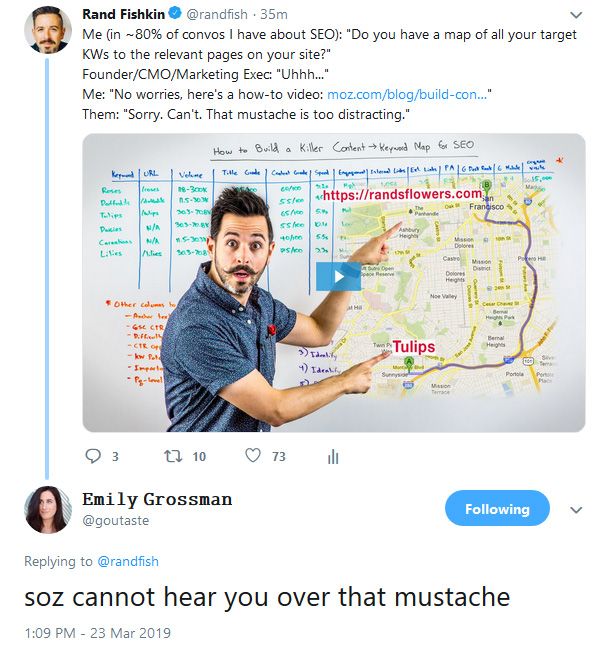Posted by randfish
Ever get that spooky feeling that Google somehow knows exactly what you mean, even when you put a barely-coherent set of words in the search box? You’re not alone. The search giant has an uncanny ability to un-focus on the keywords in the search query and apply behavioral, content, context, and temporal/historical signals to give you exactly the answer you want.
For marketers and SEOs, this poses a frustrating challenge. Do we still optimize for keywords? The answer is “sort of.” But I think I can show you how to best think about this in a few quick visuals, using a single search query.
First… A short story.
I sent a tweet
over the weekend about an old Whiteboard Friday video. Emily Grossman,
longtime friend, all-around marketing genius, and
official-introducer-of-millenial-speak-to-GenXers-like-me replied.

Ha ha Emily. I already made fun of my own mustache so…
Anywho, I searched Google for “soz.” Not because I didn’t know what it means. I can read between lines. I’m hip. But, you know, sometimes a Gen-Xer wants to make sure.
The results confirm my guess, but they also helped illustrate a point of frequent frustration I have when trying to explain modern vs. classic SEO. I threw together these seven visuals to illustrate.
There you have it friends. Classic SEO ranking inputs still matter. They can still help. They’re often the difference between making it to the top 10 vs. having no shot. But too many SEOs get locked into the idea that rankings are made up of a combination of the “Old School Five”:
- Keyword use
- Links to the page
- Domain authority
- Anchor text
- Freshness
Don’t get me wrong — sometimes, these signals in a powerful enough combination can overwhelm Google’s other inputs. But those examples are getting harder to find.
The three big takeaways for every marketer should be:
- Google is working hard to keep searchers on Google. If you help them do that, they’ll often help you rank (whether this is a worthwhile endeavor or a Prisoner’s Dilemma is another matter)
- When trying to reverse why something ranks in Google, add the element of “how well does this solve the searcher’s query”
- If you’re trying to outrank a competitor, how you align your title, meta description, first few sentences of text, and content around what the searcher truly wants can make the difference… even if you don’t win on links 😉
Related: if you want to see how hard Google’s working to keep searchers on their site vs. clicking results, I’ve got some research on SparkToro showing precisely that.
P.S. I don’t actually believe in arbitrary birth year ranges for segmenting cohorts of people. The differences between two individuals born in 1981 can be vastly wider than for two people born in 1979 and 1985. Boomer vs. Gen X vs. Millenial vs. Gen Z is crappy pseudoscience rooted in our unhealthy desire to categorize and pigeonhole others. Reject that ish.
Sign up for The Moz Top 10, a semimonthly mailer updating you on the top ten hottest pieces of SEO news, tips, and rad links uncovered by the Moz team. Think of it as your exclusive digest of stuff you don’t have time to hunt down but want to read!